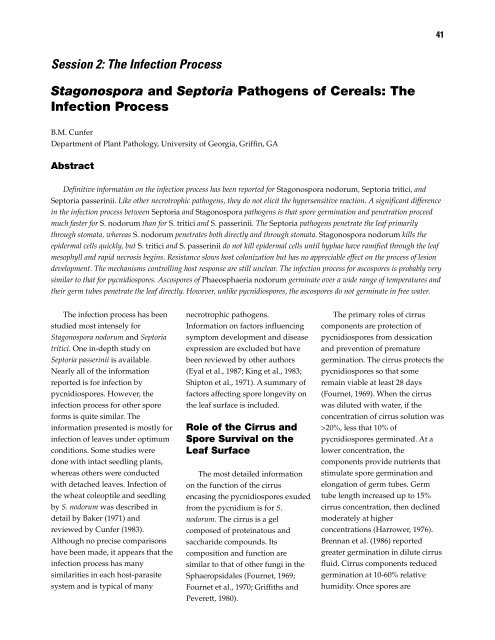Septoria and Stagonospora Diseases of Cereals - CIMMYT ...
Septoria and Stagonospora Diseases of Cereals - CIMMYT ...
Septoria and Stagonospora Diseases of Cereals - CIMMYT ...
You also want an ePaper? Increase the reach of your titles
YUMPU automatically turns print PDFs into web optimized ePapers that Google loves.
Session 2: The Infection Process<br />
<strong>Stagonospora</strong> <strong>and</strong> <strong>Septoria</strong> Pathogens <strong>of</strong> <strong>Cereals</strong>: The<br />
Infection Process<br />
B.M. Cunfer<br />
Department <strong>of</strong> Plant Pathology, University <strong>of</strong> Georgia, Griffin, GA<br />
Abstract<br />
Definitive information on the infection process has been reported for <strong>Stagonospora</strong> nodorum, <strong>Septoria</strong> tritici, <strong>and</strong><br />
<strong>Septoria</strong> passerinii. Like other necrotrophic pathogens, they do not elicit the hypersensitive reaction. A significant difference<br />
in the infection process between <strong>Septoria</strong> <strong>and</strong> <strong>Stagonospora</strong> pathogens is that spore germination <strong>and</strong> penetration proceed<br />
much faster for S. nodorum than for S. tritici <strong>and</strong> S. passerinii. The <strong>Septoria</strong> pathogens penetrate the leaf primarily<br />
through stomata, whereas S. nodorum penetrates both directly <strong>and</strong> through stomata. <strong>Stagonospora</strong> nodorum kills the<br />
epidermal cells quickly, but S. tritici <strong>and</strong> S. passerinii do not kill epidermal cells until hyphae have ramified through the leaf<br />
mesophyll <strong>and</strong> rapid necrosis begins. Resistance slows host colonization but has no appreciable effect on the process <strong>of</strong> lesion<br />
development. The mechanisms controlling host response are still unclear. The infection process for ascospores is probably very<br />
similar to that for pycnidiospores. Ascospores <strong>of</strong> Phaeosphaeria nodorum germinate over a wide range <strong>of</strong> temperatures <strong>and</strong><br />
their germ tubes penetrate the leaf directly. However, unlike pycnidiospores, the ascospores do not germinate in free water.<br />
The infection process has been<br />
studied most intensely for<br />
<strong>Stagonospora</strong> nodorum <strong>and</strong> <strong>Septoria</strong><br />
tritici. One in-depth study on<br />
<strong>Septoria</strong> passerinii is available.<br />
Nearly all <strong>of</strong> the information<br />
reported is for infection by<br />
pycnidiospores. However, the<br />
infection process for other spore<br />
forms is quite similar. The<br />
information presented is mostly for<br />
infection <strong>of</strong> leaves under optimum<br />
conditions. Some studies were<br />
done with intact seedling plants,<br />
whereas others were conducted<br />
with detached leaves. Infection <strong>of</strong><br />
the wheat coleoptile <strong>and</strong> seedling<br />
by S. nodorum was described in<br />
detail by Baker (1971) <strong>and</strong><br />
reviewed by Cunfer (1983).<br />
Although no precise comparisons<br />
have been made, it appears that the<br />
infection process has many<br />
similarities in each host-parasite<br />
system <strong>and</strong> is typical <strong>of</strong> many<br />
necrotrophic pathogens.<br />
Information on factors influencing<br />
symptom development <strong>and</strong> disease<br />
expression are excluded but have<br />
been reviewed by other authors<br />
(Eyal et al., 1987; King et al., 1983;<br />
Shipton et al., 1971). A summary <strong>of</strong><br />
factors affecting spore longevity on<br />
the leaf surface is included.<br />
Role <strong>of</strong> the Cirrus <strong>and</strong><br />
Spore Survival on the<br />
Leaf Surface<br />
The most detailed information<br />
on the function <strong>of</strong> the cirrus<br />
encasing the pycnidiospores exuded<br />
from the pycnidium is for S.<br />
nodorum. The cirrus is a gel<br />
composed <strong>of</strong> proteinatous <strong>and</strong><br />
saccharide compounds. Its<br />
composition <strong>and</strong> function are<br />
similar to that <strong>of</strong> other fungi in the<br />
Sphaeropsidales (Fournet, 1969;<br />
Fournet et al., 1970; Griffiths <strong>and</strong><br />
Peverett, 1980).<br />
41<br />
The primary roles <strong>of</strong> cirrus<br />
components are protection <strong>of</strong><br />
pycnidiospores from dessication<br />
<strong>and</strong> prevention <strong>of</strong> premature<br />
germination. The cirrus protects the<br />
pycnidiospores so that some<br />
remain viable at least 28 days<br />
(Fournet, 1969). When the cirrus<br />
was diluted with water, if the<br />
concentration <strong>of</strong> cirrus solution was<br />
>20%, less that 10% <strong>of</strong><br />
pycnidiospores germinated. At a<br />
lower concentration, the<br />
components provide nutrients that<br />
stimulate spore germination <strong>and</strong><br />
elongation <strong>of</strong> germ tubes. Germ<br />
tube length increased up to 15%<br />
cirrus concentration, then declined<br />
moderately at higher<br />
concentrations (Harrower, 1976).<br />
Brennan et al. (1986) reported<br />
greater germination in dilute cirrus<br />
fluid. Cirrus components reduced<br />
germination at 10-60% relative<br />
humidity. Once spores are









